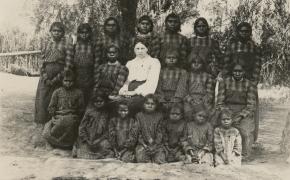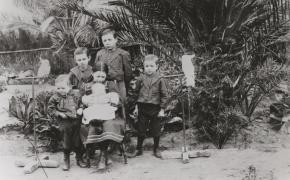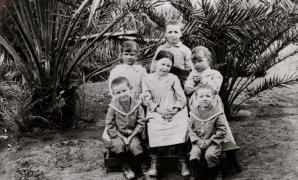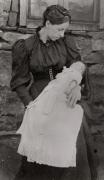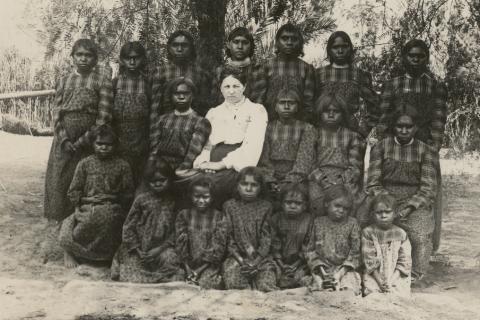"When you looked at me with those blue eyes, I knew, that you loved me. When you had left that day, I just wanted to cry and cry, but I was not permitted to let anyone know… But now you are mine after a long battle. If it were only my decision, I would come sooner to you." 1
Frieda and Carl Strehlow met in 1892, in a three-day encounter during Easter 1892, just before he left Germany to travel to Bethesda Mission in South Australia. As Frieda battled her family’s opposition to their relationship, the two continued their courtship by correspondence, and she came to Australia to marry him on 25 September 1895 at Point Pass in South Australia.
Frieda was born in Geroldsgruen, the daughter of wood factory owner C.T. Keysser. Her father died in 1879 after which time she then lived partly with her mother and stepfather and with her mother’s sister Augusta and her grandparents in Theilenhofen and later Gunzenhausen. Her grandfather was the Lutheran pastor at Theilenhofen, Johann Erhard Fischer, who co-founded (with Wilhelm Löhe) the Society for Inner Mission in Neuendettelsau in 1849. She studied at Löhe’s Industry School in 1890 and it was here that she met Carl in 1892 just before he embarked on his journey to Australia. Once Carl was in Australia, he wrote frequently to Frieda describing the mission and its environment in glowing terms.
Frieda’s letters paint a poignant picture of her youthful enthusiasm, she was looking forward to her new life and adventure in Australia. She talked about her dowry which included measured curtains for their home, and he wrote back with enthusiastic descriptions of Hermannsburg ‘most beautiful place in the whole of the Northern Territory’.2
Frieda was just 19 years of age when she travelled from Germany to Australia to join Carl in 1895.
Frieda’s life at Hermannsburg
Frieda kept a diary of her life in Australia. She also corresponded with female friends in Australia and Germany, as well as with her brother Christian Keysser in New Guinea. This wealth of information provided the basis for John Strehlow’s The Tale of Frieda Keysser, and it also means that Frieda’s life as a female missionary in Central Australia is unusually well documented; providing us with an incredibly rare insight into the life of a woman in a period when most historical accounts record the world of men. She was one of the first European women to live in Central Australia’s frontier and certainly the first recorded woman to document aspects of her life and the life of Aboriginal people around her, predating the work of other female ethnographers such as Daisy Bates and Olive Pink.
One can imagine the difficulty and isolation that Frieda experienced. It was not only the physical hardships of a harsh and unfamiliar climate, with droughts and summer temperatures of around 40°C; for several years she was the only white woman at Hermannsburg. Frieda had six children, five boys and one girl, at Hermannsburg between 1897 and 1908 in an area so remote that it took weeks of onerous travel to get anywhere should medical assistance be needed; so, each birth took place without trained medical help. Her first child, Friedrich, was born in 1897; her only daughter Martha in 1899; Rudolf in 1900; Karl in 1902; Hermann in 1905 and her youngest son Theodore in 1908. All but one of their children were sent to Germany for their education. The youngest Theodor Georg Heinrich (Ted) Strehlow (1908-1978) stayed with them at Hermannsburg until Carl’s death.
In 1910, Carl and Frieda left Hermannsburg on a family trip to Germany. The trip was both a long-overdue break and a chance to organise school placements for the eldest five of their children. They returned to Hermannsburg in 1912 with only their youngest in tow, Ted. When World War I broke out Frieda must have worried terribly for the safety of her children so far away. She had left them in Germany in the hope of providing a good education and had unwittingly left them in the maelstrom of WWI.
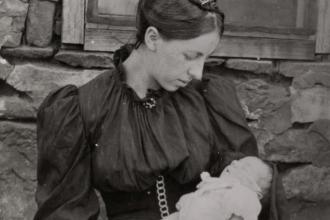
Frieda’s work with women and children at Hermannsburg.
As well as bringing up her own children, Frieda played an important role in the mission. She worked with the young girls and women, teaching them basic health practices, how to sew, how to cook using the supplies available and worked to reduce infant mortality. Like her husband, she became fluent in Arrarnta (then called Aranda) and translated several hymns.
While most attention has been on the ethnographic and linguistic work of her husband, Frieda almost certainly assisted him in this work. Kenny highlights the significant role that Frieda likely played in her husband’s ethnographic work:
The chapter ‘Birth, Smoking and Name-Giving’ in Carl Strehlow’s fifth volume is almost certainly based on information collected by his wife, Frieda Strehlow. The relevant part in the handwritten manuscripts is in Frieda’s hand; it is the only passage in these manuscripts written by her…. the topic relates to birth and women’s ritual. It is unlikely to be mere chance that this part of the manuscript is in her hand. Only with great difficulty and coercion would Carl Strehlow have been able to obtain this kind of data from women. 3
Frieda is likely to have contributed more than we know. Kenny suggests that it is likely that she contributed to the collection of Aboriginal myths reported by Carl.
The whirlwind which brings bad spirit-children, or the myths relating to female ancestors, may have been inserted by her. Her letters are often about her work with Aranda women, her close engagement with them in everyday life and indigenous beliefs. She mentions in her letters to family and friends, for example, the infanticide of twins and beliefs about spirit children. 4
The death of her husband
In mid1922 Strehlow was struck down by a mysterious illness which he himself diagnosed from his medical books as dropsy, and for the first time he did not take the service on Sunday. Ted Strehlow their son wrote in his childhood diary about this service:
I played the organ because Mum and Dad stayed at home. … The congregation remained completely silent during the first liturgy, so Herr Heinrich started singing the responses himself fairly in the wrong tune, until some men took over and ended the verse in a strangely off melody.
When Carl became seriously ill, Frieda sent their friend Hezekial to Alice Springs to send a telegram partitioning the church in South Australia to send a car to transport him to hospital. Hezekial made record timing on this journey which he undertook on foot but returned with dismal news that the request was refused. Frieda’s feelings of desperation as she faced a horrendous overland trip via a rough horse and buggy, transporting her husband in terrible agony and a young son can only be imagined. As the family left Hermannsburg all of their Arrarnta friends and flock assembled to see them off, singing Kaarrerrai worlamparinyai, a hymn Carl had translated for them to the music of Bach. The family only made it as far as Horseshoe Bend where Carl died on the 20th October 1922. That tragic story is captured in all its pain and heartbreak in The Journey to Horseshoe Bend. 4
Once again, Frieda rose to the challenge of raising her youngest son on her own, later becoming a matron at Immanuel College in Adelaide to support Theo through his education. She returned to Germany in late 1931.
- Frieda Keysser to Carl Strehlow, 22.7.1894. cited in Kenny 2013. The Aranda’s Pepa.p 26
- Carl Strehlow to Frieda Keysser, 10.10.1894 cited in Kenny 2013. The Aranda’s Pepa.p 25
- Kenny 2013 pg 45 referring to the fifth volume of Die Aranda- und Loritja-Stämme in Zentral-Australien / Strehlow 1913: 1–5
- Kenny 2013 p 46.
- Strehlow, T.G.H., 2015, 1969 Journey to Horseshoe Bend Giramondo Publishing Co / reprint original pub 1969
Media
